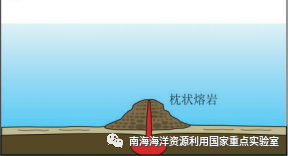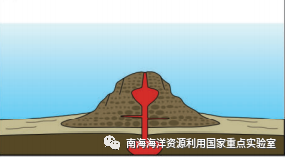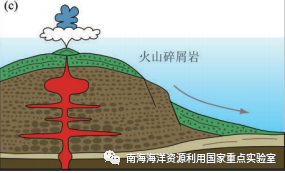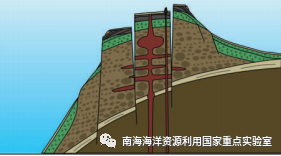洋岛-海山概述
Overview of Oceanic Island-Seamount
“海山”术语首次被使用是美国地名委员会于1983年命名的戴维森海山,最初被定义为“具有锥形特征的孤立高地”。高出洋底1Km以上的板内火山高地称为海山,随着对形成海山的地质过程及其分布的理解不断提高,严格的1000m地形限制被放宽,现今通常将“海山”一词应用于更小的范围(低至几十米)。目前,“海山”一词更普遍地适用于地形“山丘”高程,而不考虑大小河地形。大多数海山不超过海平面以上,超出海平面被称为洋岛。
The term “seamount” was first used in 1983 by the U.S. Board on Geographic Names for the Davidson Seamount and was originally defined as “an isolated highland with conical features”. As the understanding of the geological processes that form seamounts and their distribution improved, the former strict 1000m topographic limit was relaxed and the term “seamount” is now commonly applied to smaller areas (down to a few tens of meters). Currently, the term “seamount” is more commonly applied to elevation of “hill” regardless of its size and topography. Most seamounts do not rise above sea level, and those beyond sea level are called oceanic islands.
海山(洋岛)通常形成于板内,绝大多数海山主要由喷发的熔岩流构成主体,其上为碳酸盐岩。因此,海山的总体形状主要受岩浆管道系统的几何结构、喷发速率、熔岩类型和火山机构的应力控制。
Seamounts (oceanic islands) are usually formed within plates, and the majority of them are dominated by the erupted lava flows overlain by carbonate rocks. Therefore, the general shape of seamounts is controlled mainly by the geometry of the magma pipeline system, the eruption rate, the type of lava and the stress of the volcanic mechanism.
洋岛-海山的形成过程
The Formation Process of Oceanic Island-Seamount
洋岛-海山主要通过火山作用从海底开始生长,其演化历史可分为6个阶段。海山的生长可以在任一阶段终止,或在6个建造阶段完成后进入俯冲带,每个阶段在结构上是不同的。
The evolutionary history of oceanic islands and seamounts which grow from the seafloor mainly through volcanism can be divided into six stages. The growth of seamounts can stop at any of the stages or enter the subduction zone after the completion of the six stages, and each of them is structurally distinct.
①小型海山(高度为100-1000m),是现今地球大洋盆地中最为丰富的海山类型,主要通过喷发作用建立在洋壳上的海底火山,岩浆通道位于洋壳中,主要由枕状熔岩组成,少量火山碎屑岩。侵入作用较弱,除了与洋中脊重合的火山。
Small seamount (100-1000m in height). The small seamount is the type which is the most abundant in the present ocean basins. It is formed by the eruption of magmas of submarine volcanos whose channels locate in the oceanic crust. The magmas consist mainly of pillow lavas and a small amount of volcanic clastic rocks. Those volcanos are weak in their intrusive action except for those that overlap with mid-ocean ridges.

②中型海山(高度至少1000m),岩浆管道系统已成为海山本身重要的一部分,但仍处于水深700m以下的喷发。中等规模的海山主要由喷出岩构成,随着规模的增加,其侵入岩的比例也在增加。
Medium-sized seamount (at least 1000m in height). The magma pipeline system has become an important part of the medium-sized seamount, but the lavas erupt in the areas with the depth of more than 700m. The medium-sized seamounts consist mainly of eruptive rocks, and the proportion of the intrusive rocks increases as their size increases.

③浅海山(水深<700m),主要特征是海底火山碎屑岩大量增加,大部分被火山碎屑岩覆盖。
Shallow seamount (water depth<700m). The shallow seamounts are mainly characterized by a large increase in submarine volcanic clastic rocks, and they are mostly covered by those volcanic clastic rocks.

④洋岛阶段,当大型海山顶出现在海平面以上并转变为陆上火山活动时形成洋岛。现今所知的大多数新生火山岛在洋岛阶段出现后保持不久就沉没了,因为浅水海山的大部分火山碎屑岩顶部容易受到波浪作用的侵蚀,只有在大量熔岩流涌出且在很长一段时间内超过了波浪的侵蚀时,洋岛才会继续存在。
Oceanic island. When the peaks of large seamounts appear above sea level, they will form oceanic islands under the land-based volcanic activities. Most of the presently known nascent volcanic islands sink soon after the stage of oceanic island because most of the volcanic clastic peaks of shallow-water seamounts are susceptible to erosion by waves, and oceanic islands continue to exist only when large lava flows emerge and outweigh wave erosion over a long period of time.

⑤平顶海山,晚期的海山停止所有火山活动,并下沉到海平面以下,形成环礁。停止活动的海山不会生长了,因为没有驱动热对流的内部热源,也不太可能崩塌。可能被珊瑚礁所覆盖,尽管岩石圈下沉,但珊瑚礁的生长可能会使洋岛顶部长时间浮现。一旦完全淹没,海山就不会再被侵蚀,使得一些古老的海山长期保留,例如马尼亚纳海沟外侧西太平洋的白垩纪以来的麦哲伦海山。
Flat-topped seamount. The seamounts at late stage cease all volcanic activities and sink below sea level to form atolls. The seamounts that stop being active do not grow anymore because there is no internal heat source driving thermal convection and are less likely to collapse. It may be covered by coral reefs whose growth may keep the peaks of oceanic islands afloat for a long period of time in spite of the sinking lithosphere. Once completely submerged, seamounts are no longer eroded, allowing some ancient seamounts to be preserved for a long time, and the Magellanic Seamount in the western Pacific Ocean off the Mariana Trench which has existed since the Cretaceous is a case.

⑥海山破坏阶段,在俯冲或洋盆关闭过程中海山地质生命将结束,海山向俯冲带运移。角度陡的俯冲可能使海山-洋岛裂离破碎,而俯冲到较浅处的洋岛-海山增生楔体通常在海沟向洋侧斜坡上破裂瓦解和向陆弧侧滑塌增生,以及与海沟内浊积岩一起刮削拼贴-底辟增生与逆冲推覆增生。
Seamount destruction. In the phase of seamount destruction, the geological life of seamounts will end during subduction or close of oceanic basins, and seamounts will be transported to the subduction zones. The steep subduction may break up seamounts and oceanic islands, while those accretionary wedges of seamounts and oceanic islands which subduct to shallow areas usually break up and disintegrate on the oceanic slopes of the trench and slip on the landward side as well as scrape and collapse with turbidites in the trench-bottom-breaking accretion and retrograde thrust accretion.

尽管这6个阶段描述了非常大的海山完整发育历史,但大多是海山从未达到洋岛阶段,未发育成型的小型海山在到达俯冲带时可能已被沉积物完全掩埋,甚至可能直接被俯冲带吞没。
Although these six stages describe the complete developmental history of large seamounts, most of them never reach the oceanic island stage and small undeveloped seamounts may have been completely buried by sediments by the time they reach the subduction zone or may even be directly engulfed by the subduction zone.
参考文献
[1]袁四化,潘桂棠,任飞.洋岛-海山研究进展及其对于重建洋板块的意义[J].地球科学,2020,45(08):2826-2845.
[1]范建军,李才,牛耀龄,解超明,王明.造山带板内洋岛-海山残片的识别及地质意义[J].地球科学,2021,46(02):381-404.
 公众号
公众号